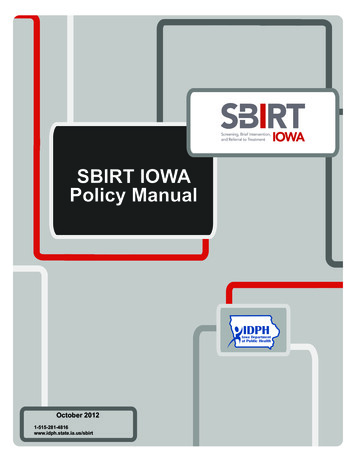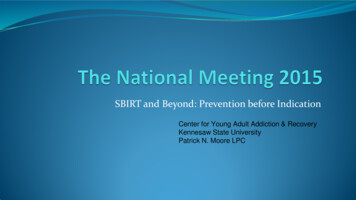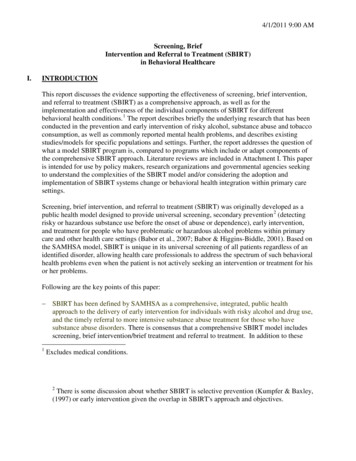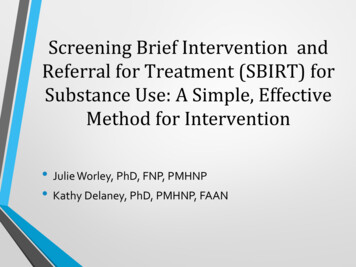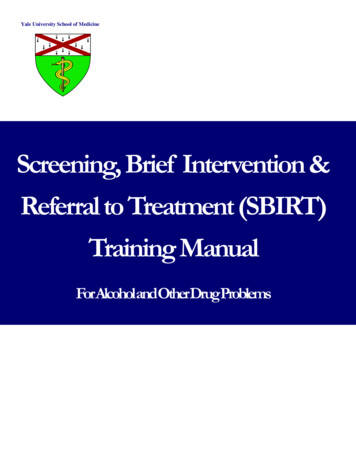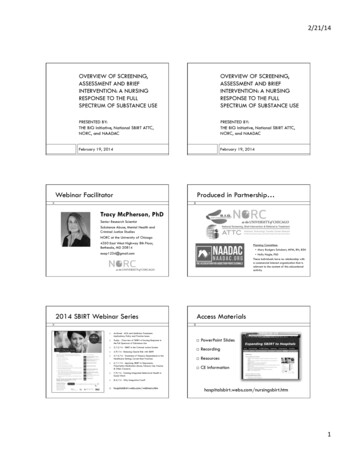
Transcription
2/21/14OVERVIEW OF SCREENING,ASSESSMENT AND BRIEFINTERVENTION: A NURSINGRESPONSE TO THE FULLSPECTRUM OF SUBSTANCE USEOVERVIEW OF SCREENING,ASSESSMENT AND BRIEFINTERVENTION: A NURSINGRESPONSE TO THE FULLSPECTRUM OF SUBSTANCE USEPRESENTED BY:THE BIG Initiative, National SBIRT ATTC,NORC, and NAADACPRESENTED BY:THE BIG Initiative, National SBIRT ATTC,NORC, and NAADACFebruary 19, 2014February 19, 2014Webinar FacilitatorProduced in Partnership Tracy McPherson, PhDSenior Research ScientistSubstance Abuse, Mental Health andCriminal Justice StudiesNORC at the University of Chicago4350 East West Highway 8th Floor,Bethesda, MD 20814Planning Committee: Mary Rodgers Schubert, MPM, RN, BSNesap1234@gmail.com2014 SBIRT Webinar Series Today - Overview of SBIRT: A Nursing Response tothe Full Spectrum of Substance Use3/12/14 - SBIRT in the Criminal Justice System 4/9/14 - Reducing Opioid Risk with SBIRT Access MaterialsArchived - ACA and Addiction Treatment:Implications, Policy and Practice Issues Holly Hagle, PhDThese individuals have no relationship witha commercial interest organization that isrelevant to the content of this educationalactivity. PowerPoint Slides Recording5/14/14 - Treatment of Tobacco Dependence in theHealthcare Setting: Current Best Practices Resources6/11/14 - Applying SBIRT to Depression,Prescription Medication Abuse, Tobacco Use, Trauma& Other Concerns CE Information7/9/14 - Training Integrated Behavioral Health inSocial Work 8/6/14 - Why Integrative Care? ebs.com/nursingsbirt.htm1
2/21/14Ask QuestionsCE Credit 1.5 free CEs approved by NAADAC and NBCC,accredited by the American Probation & ParoleAssociation, and accepted by OASAS.1.5 ANCC Nursing Continuing Education Credits for 10and approved through the University of PittsburghSchool of Nursing, in Pittsburgh, PA. The University of Pittsburgh School of Nursing is accreditedas a provider of continuing nursing education by theAmerican Nurses Credentialing Center’s Commission onAccreditation.Ask questionsthrough the“Questions”PaneWill beansweredlive at ical FacilitatorMisti Storie, MS, NCCDirector of Training &Professional DevelopmentNAADAC, the Associationfor Addiction ProfessionalsCo-PresenterDeborah S. Finnell, DNS,PHMHP-BC, CARN-AP, FAANJohns Hopkins UniversitySchool of Nursingdfinnel1@jhu.edumisti@naadac.orgDisclosure: This presenter has no relationship with a commercial interest organization thatis relevant to the content of this educational activity.Co-PresenterLauren Broyles, PhD, RNOverview of Screening, Assessment, and Brief Intervention:A Nursing Response to the Full Spectrum of Substance UseVA Pittsburgh HealthcareSystem & University ofPittsburghlauren.broyles@va.govDisclosure: This presenter has no relationship with a commercial interest organization thatis relevant to the content of this educational activity2
2/21/14Objectivesü Explain how and why screening, assessment, and briefintervention, and referral to treatment (SBIRT) is anappropriate set of clinical strategies for nurses, across allhealth care settings, to identify and manage substance useCitationThe majority of the following material is the result of worksupported by grant #RRP 09-064 from the U.S. Department ofVeterans Affairs, Quality Enhancement Research Initiative(QUERI) program, awarded to Dr. Broyles, and with resourcesand the use of facilities at the VA Pittsburgh HealthcareSystem, Pittsburgh, PA. Dr. Broyles is currently supported by aCareer Development Award (CDA01-014) from the HealthServices Research and Development Service of the U.S.Department of Veterans Affairs. The views expressed in thismaterial are those of the authors and do not necessarily reflectthe position or policy of the Department of Veterans Affairs orthe U.S. government. ü Differentiate screening, assessment, and brief interventionü Articulate three stylistic strategies for incorporating screening,assessment, and brief intervention into routine nursingpracticeü Analyze a simulated patient interview for key componentsand stylistic elements of a brief interventionBackgroundu TerminologySubstance Use DisordersAbuse & Dependenceu Changes in criteria u Conceptsu REMOVED: Legal problemsADDED: Craving, or a strong desire or urge to use thesubstanceSubclassifications (based on 11 criteria) Mild (2 to 3 symptoms)Moderate (4 to 5 symptoms)Severe (6 or more mfactsheet/dsmfact.pdfAlcohol Use Terminologyu Hazardous alcohol useou Pattern of drinking that carries elevated risk of harm suchas the consumption of a sufficient amount of alcohol tocause mental or physical impairmentHarmful alcohol useoPattern of drinking that causes harm to health including 1)physical/physiological (e.g., fatty liver, hypertension), 2)mental/psychological (e.g., depression related to heavydrinking)Babor, T., Rehm, J., Jernigan, D., Vaeth, P., Monteiro, M., & Lehman, H. (2012). Alcohol, diabetes,and public health in the Americas. Rev Panam Salud Publica, 32(2), 151-155.Drinkers Pyramid3 - 7 % Drinkers with anAlcohol Use Disorder10 - 15% HazardousDrinkers35 - 40% Low-riskDrinkers40% Abstainers3
2/21/14Definition of a Standard DrinkStandard alcohol-a-day.htmlHazardous Drinking Criteria Men no more than 4 in a day AND no more than14 in a weekExampleu All over age 65 years No more than 3 drinks in aday AND no more than 7 drinks in a weekNot within guidelines:52 year old man drinking 3 beers every day– He is below daily limit but is having 21 beers/weekWomen No more than 3 drinks in a day AND nomore than 7 drinks in a weeku Within guidelines:52 year old man who drinks:– 3 beers Monday, 2 beers Wednesday– 4 beers Thursday night, 3 beers Friday nightLower limits or AbstinenceTaking medication(s) that interact with alcoholHave a health condition exacerbated by alcohol Pregnant (abstinence) –He has no more than 4/day and has a total of 12 over theweekNational Institute on Alcohol Abuse and Alcoholism. (2007). Helping Patients Who Drink Too Much,A Clinician's Guide. Rockville, MD: NIAAA.Why?Objec,ve1:Nurses across all health care settings can andshould identify and manage substance useu Sheer numberu Extended patient contactu Regular, stable providersu Existing skill setsu Practice style that is congruent with SBIRTu “Most trusted profession”u Push for interdisciplinary emiesPress:Washington,DC.4
2/21/14How Does SBIRT Fit in with Nursing Practice? Alcoholuseandusedisordersarecommon Linktoacute/chroniccondi,ons Screening earlydetec,onofW/D Referralopportuni,esandresources Admission/Intake “Teachablemoment” “Upstream,”preven,onopportunity Objec,ve2:Differentiate screening, assessment, and briefinterventionu u s?The Three SBIRT ComponentsSBIRTComponent1) Screening2) Briefintervention3) Referral totreatmentPurposeTools for Doing it Standardized screeningAssesses the extent ofquestionnaires such as thesubstance use andAUDIT-Cidentifies the appropriatelevel of treatment, if anyFocuses on increasingawareness and insightabout substance use, andincreasing motivation forchanging behavior Brief negotiated interview(BNI), a structured 5-10minute conversation withcertain elements and/orstrategiesProvides those needingmore extensive treatmentwith access to specialtycare Clear referral processes Patient education resourcesScreening & Assessment Overall goal/purpose Variety of screening instruments Introduce screening tools used administration,scoring, cut-points, interpretationWhat to do with a positive screenComponents: Screening and Assessment, BriefIntervention, Referral to TreatmentRelationship Between SBIRT and theDrinkers Pyramid3 - 7 % drinkers with an Alcohol Use DisorderRTSBI10 - 15% hazardous drinkers35 - 40% low-risk drinkersPositivefeedback,preventionmessage, ornothing40% abstainersScreening Goal of SBIRT: To decrease the burden of alcoholrelated injury, disease, and disability Goal: Early determination ofwho needs further assessmentUniversal “first pass”Use validated tool for yourpopulation5
2/21/14Alcohol Screening DIT-CTargetPopula8onAUDIT/AUDIT- 8onTest(AUDIT)–drinkingConsump8on(AUDIT- Hazardousdrinking ceAdults 3 item short-version of full AUDITQuantity, frequency, binge drinking over pastyearPositive screen 3 for women and all over age 65 years 4 for men 8 suggestive of dependenceNational Institute on Alcohol Abuse and Alcoholism. (2007). Helping patients who drink toomuch, A clinician's guide. Rockville, MD: NIAAA.AUDITHazardous Drinking CriteriaHow often do you have a drink containing alcohol? Never [0 points]Monthly or less [1 point]2 to 4 times a month [2 points]2 to 3 times a week [3 points]4 or more times a week [4 points]How many drinks containing alcohol do you have on a typical day when you aredrinking?1 or 2 [0 points]3 or 4 [1 point]5 or 6 [2 points]7, 8, or 9 [3 points]10 or more [4 points] How often do you have six or more drinks on one occasion?Never [0 points]Less than monthly [1 point]Monthly [2 points]Weekly [3 points]Daily or almost daily [4 points] Men no more than 4 in a day AND no more than14 in a weekWomen No more than 3 drinks in a day AND nomore than 7 drinks in a weekAll over age 65 years No more than 3 drinks in aday AND no more than 7 drinks in a weekLower limits or AbstinenceTaking medication(s) that interact with alcoholHave a health condition exacerbated by alcohol Pregnant (abstinence) Total Points:Bradley, K.A., DeBenedetti, A.F., Volk, R.J., Williams, E.C., Frank, D., & Kivlahan, D.R. (2007).AUDIT-C as a brief screen for alcohol misuse in primary care. Alcoholism: Clinical and ExperimentalResearch, 31(7), 1208-1217.National Institute on Alcohol Abuse and Alcoholism. (2007). Helping Patients Who Drink Too Much,A Clinician's Guide. Rockville, MD: NIAAA.Assessing for Hazardous DrinkingAssessing for Alcohol Use Disorder1) Number of drinks/week How many days/week the patient drinks How many drinks s(he) usually has when drinking 2) Binge drinking Goals:For women: Ask how often she has 3 drinks or more onsingle occasionFor men: Ask how often he has 4 drinks or more on a singleoccasionDetermining risk for withdrawalDetermining potential need for further assessment and/orreferralHighly suggestive of moderate and severesubclassification CAGE: 2 or more affirmative responses AUDIT-C: Score -79.htm6
2/21/14Assessing for Recovery Co-PresenterPeople’s behavior and situation is not static.Deborah S. Finnell, DNS,PHMHP-BC, CARN-AP, FAANAssess further for individuals who report a historyof alcohol and/or drug use.Johns Hopkins UniversitySchool of NursingImportant to assess for risk when life circumstancesor health status changes, and/or when undergoingmedical/surgical procedure.Would you consider yourself to be a person inrecovery?dfinnel1@jhu.eduDisclosure: This presenter has no relationship with a commercial interest organization thatis relevant to the content of this educational activitySingle Drug Screening QuestionDrug Abuse Screening Test (DAST)How many times in the past year have you had used anillegal drug or used a prescription medication for nonmedical reasons?u What is it?u What are the strengths?u What are the weaknesses?––Sensitivity of 100% (true positives: correctlyidentified as having the problem); Specificity of74% (true negatives: correctly identified as nothaving the problem) Smith, P. C., Schmidt, S. M., Allensworth-Davies, D., & Saitz, R. (2010). A single-questionscreening test for drug use in primary care. Archives of Internal Medicine,170(13), 1155 1160.Yields a quantitative index of problems related to drug misuseSensitive screening tool for at-risk drug use–Does not include alcohol use–Focus on dependence–Does not distinguish between active and inactive use–Does not include quantity, frequency, pattern, duration or type of drugusedDAST 10 Interpretation(Each “Yes” response 1)Drug Abuse Screening Test – DAST convulsions,bleeding)?YesNoYudko, E., Lozhkina, O., & Fouts, A. (2007). A comprehensive review of the psychometric propertiesof the Drug Abuse Screening Test. Journal of Substance Abuse Treatment, 32(2), 189-198.ScoreDegreeofProblemsRelatedtoDrugAbuse01- nSubstan,alLevelIntensiveassessment3- ‐56- ‐8SuggestedAc5onYudko, E., Lozhkina, O., & Fouts, A. (2007). A comprehensive review of the psychometric propertiesof the Drug Abuse Screening Test. Journal of Substance Abuse Treatment, 32(2), 189-198.7
2/21/14Common Assumptions About HealthBehavior ChangeObjec,ve3:Articulate three stylistic strategies forincorporating screening, assessment, and briefintervention into routine nursing practice.u u Common assumptions about health behaviorchangeTranstheoretical ModelCommon Assumptions About HealthBehavior Change (cont.) This person ought to change This person is ready to change This person’s health is a prime motivating factor for himor herIf he or she does not decide to change his or herbehavior, the consultation has failedD'Onofrio, G., & Degutis, L. C. (2002). Preventive care in the emergency department: screeningand brief intervention for alcohol problems in the emergency department: A systematicreview. Academic Emergency Medicine,9(6), 627-638.Stages of ChangePrecontemplation Patients are either motivated to change, or not Now is the right time to consider change A tough approach is always best I’m the expert—he or she must follow my tionD'Onofrio, G., & Degutis, L. C. (2002). Preventive care in the emergency department: screeningand brief intervention for alcohol problems in the emergency department: A systematicreview. Academic Emergency Medicine,9(6), 627-638.Brief mbehaviors.ProgressinBehaviorModifica;on,28,183- ‐218.Brief Intervention What it is, is not Target patients “Brief Negotiated Interview” (BNI) BNI role playsu Based on Transtheoretical Model and motivationalinterviewing Critiqueu Geared towards hazardous drinkersu Short (5-15 minute) dialogue involving: Feedback and engagement Simple advice or brief counseling Goal setting and follow-up8
2/21/14The Brief Negotiated Interview1) Raise the SubjectEstablish rapport and permission2) Provide FeedbackReview screen, risk, guidelines3) Enhance MotivationExplore pros and consAssess readiness to changeDevelop discrepancy (“rub”)Role Play # 1u D'Onofrio, G., Pantalon, M. V.,Degutis, L. C., Fiellin, D. A., &O'Connor, P. G. (2005). Developmentand implementation of anemergency practitioner–performedbrief intervention for hazardous andharmful drinkers in the emergencydepartment. Academic EmergencyMedicine, 12(3), 249-256.4) Negotiate and AdviseExplore options, negotiate planConsider follow-upu John Sawyer is a 60-year-old male who consumes 4-5standard drinks on a regular basis and was admitted to thehospital for chronic renal disease. His course was complicatedby neuropathy (numbness) in his lower extremities, especially hisfeet, which is likely attributable to poor diabetes management.The nurse is completing the nursing admission form. The hospitalhas recently changed the admission form to include informationabout alcohol, tobacco, and other drug use. The nurse is notcomfortable with the change and had limited instruction on howto obtain this additional information from the patient.Co-PresenterLauren Broyles, PhD, RNVA Pittsburgh HealthcareSystem & University erDisclosure: This presenter has no relationship with a commercial interest organization thatis relevant to the content of this educational activityStep # 1: Raise the SubjectBrief Negotiated Interview Steps Establishing rapport, permissionIntroduces subject, sets stage Present in context of health risks“We often go over different health risks with patients.Is it OK if we spend a few minutes talking about your use ofalcohol?”9
2/21/14Step # 2: Provide FeedbackStep # 3: Enhance Motivation Review drinking patterns and screening results Compare/contrast with NIAAA-guidelines u Assess readiness to changeu Develop discrepancyMake connections re: risk“What connections do you see between your [healthcondition/reason for admission] and your drinking?” Personalize health riskReadiness to ChangeDeveloping Discrepancy1) Using readiness ruler:“How ready are you on a scale of 1 to 10 to changeyour drinking if ‘1’ means not ready at all and ’10’“What made you say a 6 and not a 2?”means very ready?”and then,NOTREADY12VERYREADY3456789“What would it take for you to move to a 7?”10Developing DiscrepancyStep #4: Negotiate and Advise2) Explore pros and cons “What’s the next step?” or “What will work for you?” Start with patient’s ideas Help generate menu of options Encourage specificity“What are some of good things about drinking for you?“What are some of the not so good things?Summarize briefly and raise question“So, on the one hand you said [X] and on the other you said[Y] . . . Where does that leave you?”Negotiate a goal Reiterate adviceSummarizeFollow-up?Thank patient10
2/21/14ReadinessRulerGoalsNotreadyOffer:(0- ‐3) Yourfeedbackandconcerns Furthercontact Referralop,onsDiscussionQues8ons/Approach “Isthereanythingyouwouldwanttoknowabout?” �� �Unsure(4- ‐6)Facilitateabilityto: Nameproblemthroughpros/consdiscussion Understandownmixedfeelings(ambivalence) � “WhatconcernsdoYOUhaveaboutyouruseof?”Ready(7 )Helppa,entschoose: sesswhathasworkedinpast;offerback- 210- ‐1217.Co-PresentersDisclosure: These presenters have no relationship with a commercial interest organizationthat is relevant to the content of this educational activity.Mr. SawyerObjec,ve4:Analyze a simulated patient interviewfor key components and stylisticelements of a brief interventionu Role Play 2u Use BNI ChecklistMr. Sawyer was admitted to the hospital for stage 3chronic renal disease two days ago. His course wascomplicated by neuropathy (numbness) in his lowerextremities, especially his feet, which is likelyattributable to poor diabetes management. Hementioned that he is a “moderate” drinker.Target Health Behavior – Alcohol UseSocial HistoryMr. Sawyer drinks 4 to 5 beers most evenings during dinnerand while watching television. Approximately every othermonth he drinks up to eight beers or mixed drinks whileplaying poker or watching sports at the local bars withfriends. He has never required a drink in the morning as an‘eye-opener.’ Mr. Sawyer’s wife has been nagging him tocut down because he has been experiencing neuropathy.However, he has never tried to cut down. Mr. Sawyer hasnever had a DWI and his drinking to his knowledge has notaffected his work.Mr. Sawyer is a native to the Pittsburgh area and hasbeen married for 35 years. He has two adult childrenwho both live independently, but visit often. He hasworked as a custodian for the Pittsburgh SchoolSystem for the last 42 years. He is an avid Pittsburghsports fan and poker player at the American Legionduring his spare time to have a good time and easehis stress.11
2/21/14Relevant Past Medical, Psychosocial,Family HistoryMr. Sawyer has a history of diabetes mellitus type II.He is aware that use of alcohol may contribute todiabetic complications including diabetic neuropathy.Diabetes runs in his family, and he has a cousin who hedescribes as “a hard-core alcoholic.”Role Play #2 Complete the Brief Negotiated Interview (BNI)Checklist as you listen to the interaction.Role Play #2How well did the nurse cover the 4 steps in a BNI?ResourcesHow well did the nurse use a reflective patient-centeredstyle?What did the nurse do well in this interaction? Whatneeds some additional practice or polish?What strategies does the nurse use that you might like totry in your own practice?What stumbling blocks do you anticipate in delivering SBIin your practice?NIAAA “Clinician’s Guide”www.niaaa.nih.gov/guideNIAAA “Rethinking Drinking”www.rethinkingdrinking.niaaa.nih.gov/12
e/sbirt/Guide for Youth Screening and Brief Intervention.pdfSAMHSA/CSAT Treatment Improvement Protocols BNI ARTBrief Interventions and Brief Therapies forSubstance Abuse, Chapter 2: Brief ww.bu.edu/bniartContact InformationAsk QuestionsDeborah S. Finnell, DNS, PHMHP-BC, CARN-AP, FAANJohns Hopkins University School of Nursingdfinnel1@jhu.eduAskquestionsthrough the“Questions”PaneLauren Broyles, PhD, RNVA Pittsburgh Healthcare System & University ofPittsburghlauren.broyles@va.govWill beansweredlive at theend13
2/21/14In Our Last Few Moments CE Credit PowerPoint Slides Recording Survey Follow-up Email 2014 SBIRT Webinar Series The University of Pittsburgh School of Nursing is accreditedas a provider of continuing nursing education by theAmerican Nurses Credentialing Center’s Commission t.htmThank You for Attending!Archived - ACA and Addiction Treatment:Implications, Policy and Practice IssuesToday - Overview of SBIRT: A Nursing Response tothe Full Spectrum of Substance Use3/12/14 - SBIRT in the Criminal Justice System4/9/14 - Reducing Opioid Risk with SBIRT5/14/14 - Treatment of Tobacco Dependence in theHealthcare Setting: Current Best ta.org/ATTC6/11/14 - Applying SBIRT to Depression,Prescription Medication Abuse, Tobacco Use, Trauma& Other Concerns7/9/14 - Training Integrated Behavioral Health inSocial Work 8/6/14 - Why Integrative Care? hospitalsbirt.webs.com/webinars.htmSingle Alcohol Screening QuestionHow many times in the past year have you had five(men) or four (women and individuals over age 65)drinks or more in a day?) 1.5 ANCC Nursing Continuing Education Credits for 10and approved through the University of PittsburghSchool of Nursing, in Pittsburgh, PA. hospitalsbirt.webs.com/nursingsbirt.htm 1.5 free CEs approved by NAADAC and NBCC,accredited by the American Probation & ParoleAssociation, and accepted by OASAS.Sensitivity of 82% (true positives: correctly identified ashaving the problem)Specificity of 79% (true negatives: correctly identified asnot having the problem)National Institute on Alcohol Abuse and Alcoholism. (2007). Helping Patients Who Drink Too Much, AClinician's Guide. Rockville, MD: inars.htmAre Patients Accepting of Nurse-DeliveredSBIRT?During my stay in the hospital it would be ok withme if my nurseAsked me about my use of alcoholDiscussed my use of alcohol with meStronglyAgree/Agree95%95%Broyles, L. M., Rosenberger, E., Hanusa, B. H., Kraemer, K. L., & Gordon, A. J. (2012).Hospitalized patients’ acceptability of nurse‐delivered screening, brief intervention, andreferral to treatment. Alcoholism: Clinical and Experimental Research, 36(4), 725-731.Smith, P.C., Schmidt, S.M., & Saitz, R. (2009). Primary care validation of a single-question alcohol screening test.Journal of General Internal Medicine, 24(7), 783-788.14
2/21/14If I were a person concerned about my own use ofalcohol, it would be ok with me if my nurseStronglyAgree/AgreeProvided me with brief counseling about alcohol during myhospital stay87%Gave me a booklet with ideas on how to change my use ofalcohol88%Game me information about alcohol self-help groups availablein my area86%Offered to refer me to an alcohol program78%As part of my care, my nurse should feel free to ask me howmuch alcohol I drink92%If my drinking is affecting my health (such as my blood pressure)my nurse should advise me to cut down94%If my drinking is affecting my health (such as my blood pressure)my nurse should advise me to quit drinking84%If my nurse offered me a blood test that could tell if I amdrinking too much for my health, I would want to be tested84%(Broyles et al., 2011)Relationships Between TTM eparationActionMaintenanceCONSCIOUSNESS RAISINGDRAMATIC RELIEFENVIRONMENTAL RCEMENT MANAGEMENTHELPING RELATIONSHIPSCOUNTERCONDITIONINGSTIMULUS CONTROLPros and ConfidenceCons and ne(pp.1997- ‐2000).SpringerNewYork.15
Mary Rodgers Schubert, MPM, RN, BSN Holly Hagle, PhD These individuals have no relationship with a commercial interest organization that is relevant to the content of this educational activity. 2014 SBIRT Webinar Series ! Archived - ACA and Addiction Treatment: Implications, Policy and Practice Issues !
